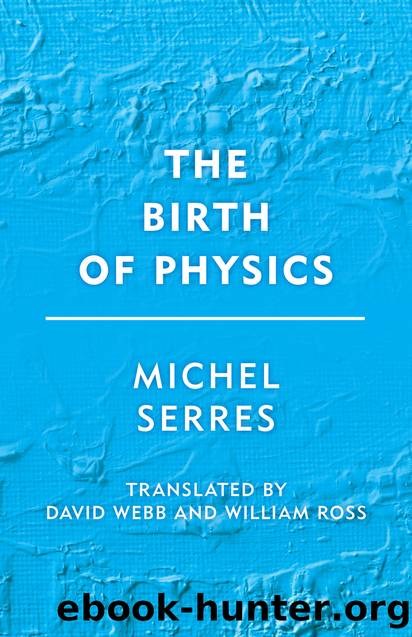The Birth of Physics by Michel Serres

Author:Michel Serres
Language: eng
Format: epub
ISBN: 9781786606266
Publisher: Rowman & Littlefield Publishers
NOTES
1ââTo the Physicists μεÏÎÏÏα denoted all the phenomena of the sky including the heavenly bodies as well as atmospheric occurrences and certain phenomena on earth, earthquakes, volcanoes, etc., which had similar causes, i.e. the contents of Lucr. V and VI. Aristotle first confined the use of the word to the atmospheric and associated terrestrial phenomenaâ, Lucretius, De rerum natura, ed. C. Bailey, Vol. III (1551).
2âSerres, Hermès IV, La distribution (Paris: Minuit, 1977), 9â14.
3âIn French, bassin is an alternative name for the pelvis.
4âThis image and those that follow are drawn from the opening of Book 2.
5â6: 591â95. Serres emphasises terms from the whole phrase, which runs as follows: âBut if there is no breaking forth, yet the impetuous air itself and the furious force of wind is distributed abroad through the many interstices of the earth like an ague, and thus transmits the trembling; just as, when cold penetrates deep into our limbs, it shakes them, making them tremble and quake against our willâ.
6ââThen may come the confused ruin of the worldâ (6: 608).
7âThe universal rush to equilibrium is double. If it is the fall of heavy bodies, it is mechanics, if it is automation, it is physics. The fall is the mechanical equivalent of atomisation, and it is more simple. It says, in pure movement, what dissemination says in matter. Now, if something exists, this is because aggregation takes place, physically speaking, by and in matter. There is an exception to the general rule of irreversible atomisation. Hence its mechanical equivalent, simpler in pure movement: the clinamen, as a local deviation from equilibrium.
8âSerres: It should be noted that in Book 2, immediately preceding the description of the clinamen, lightning and thunder hurl their flame and cross the lines of rain with their oblique flight (transversosque volare per imbris fulmina, nunc hinc, nunc illinc, here and there). The meteorological model precedes theory here.
9ââPleasant it is, when on the great sea the winds trouble the waters, to gaze from the shore upon anotherâs great tribulationâ (2: 1â2).
10âSerres: Lightning, of course, occurs nunc hinc, nunc illinc, in 6: 199 as in 6: 214.
11âSerres: 6: 923â35 repeats again, very closely, 6: 217â29. These repetitions are relatively frequent in the text. They always, or almost always, bear on canonical principles. This is the usual style of all scientific exposition. To speak of interpolation here would come down to this: a scientific treatise, by its infinite repetitions, would always be interpolated. No. This is a vortical text, exerting an attraction over long distances.
12âThis citation and those that follow are taken from the opening of Book 2.
13âEpicurus, fr. 68
14âSerres: It does not seem imprudent to me here to compare the atomist approach of multiple explanations and the aforesaid equivalence of hypotheses in astronomy. Some late commentators, like Proclus and Simplicius, attribute the idea of a multiplicity of possible hypotheses for an observed result to Hipparchus (e.g. the movement of the world), without our having texts or sources in which he states it explicitly. R. Blanché, however, takes
Download
This site does not store any files on its server. We only index and link to content provided by other sites. Please contact the content providers to delete copyright contents if any and email us, we'll remove relevant links or contents immediately.
The Complete Stick Figure Physics Tutorials by Allen Sarah(7273)
Secrets of Antigravity Propulsion: Tesla, UFOs, and Classified Aerospace Technology by Ph.D. Paul A. Laviolette(5244)
Thing Explainer by Randall Munroe(3854)
The River of Consciousness by Oliver Sacks(3503)
The Order of Time by Carlo Rovelli(3101)
How To by Randall Munroe(2976)
A Brief History of Time by Stephen Hawking(2918)
I Live in the Future & Here's How It Works by Nick Bilton(2907)
The Great Unknown by Marcus du Sautoy(2621)
What If?: Serious Scientific Answers to Absurd Hypothetical Questions by Randall Munroe(2594)
Midnight in Chernobyl by Adam Higginbotham(2439)
Blockchain: Ultimate Step By Step Guide To Understanding Blockchain Technology, Bitcoin Creation, and the future of Money (Novice to Expert) by Keizer Söze(2414)
Networks: An Introduction by Newman Mark(2308)
The Meaning of it All by Richard Feynman(2272)
Easy Electronics by Charles Platt(2256)
The Tao of Physics by Fritjof Capra(2208)
Midnight in Chernobyl: The Untold Story of the World's Greatest Nuclear Disaster by Adam Higginbotham(2133)
When by Daniel H Pink(2061)
Introducing Relativity by Bruce Bassett(2052)
